Economics Report: Examining Economic Principles and Market Dynamics
VerifiedAdded on 2023/01/13
|10
|2502
|36
Report
AI Summary
This economics report provides a comprehensive overview of fundamental economic principles, encompassing both micro and macroeconomics. It delves into the core concepts of demand and supply, illustrating their impact on market dynamics and equilibrium. The report examines the influence of various market structures, including perfect competition, oligopoly, and monopoly, on pricing strategies and market outcomes. It explores the factors affecting demand, such as income and consumer preferences, and supply, analyzing how these forces interact to shape market behavior. Furthermore, the report discusses the implications of technological advancements on labor markets and the role of government policies, like minimum wage, in influencing employment and economic growth. The analysis includes relevant figures and diagrams to elucidate the complex interplay of economic variables, offering a clear understanding of how these principles affect real-world scenarios and business decisions. The report concludes by summarizing the key takeaways regarding pricing decisions in various market structures.
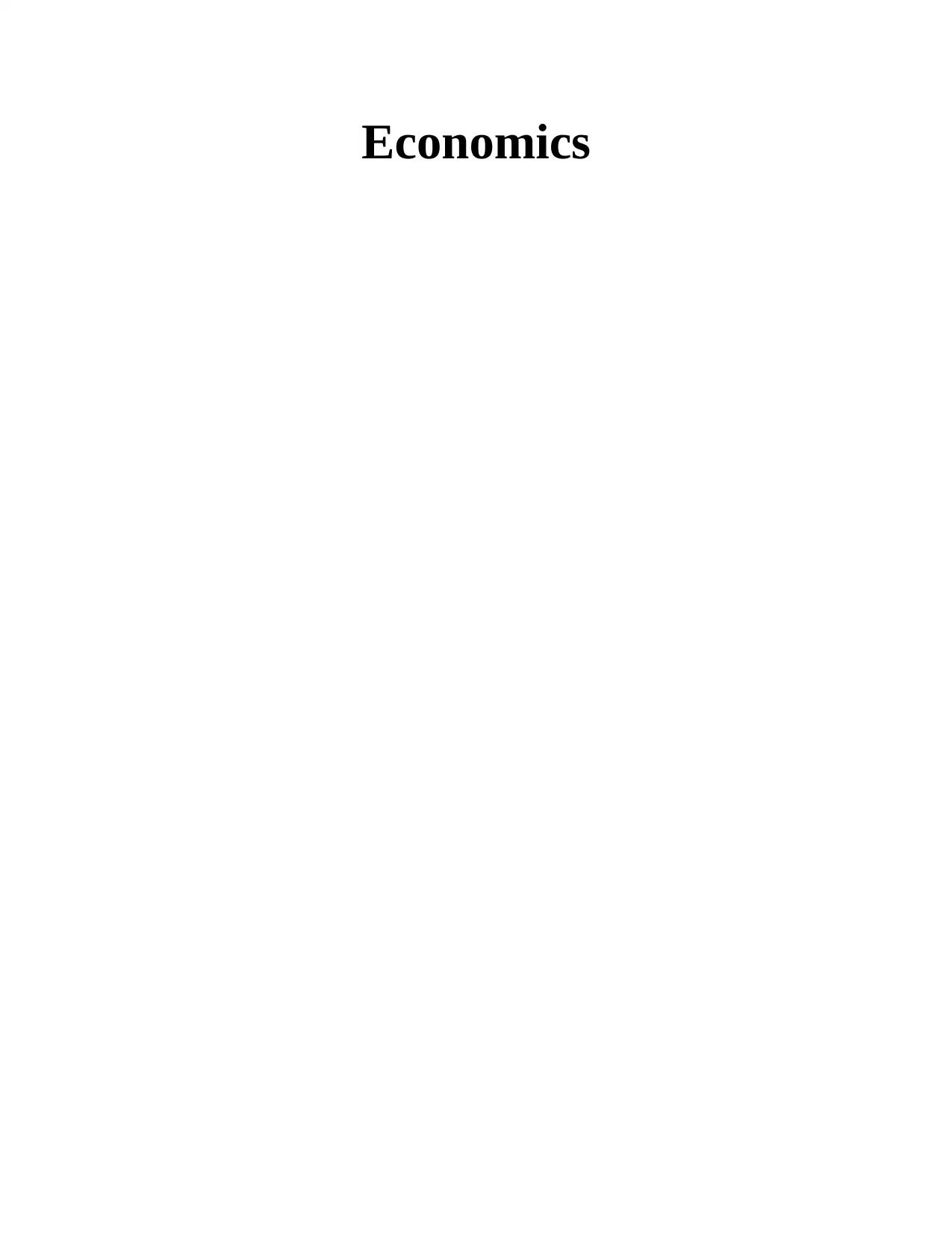
Economics
Paraphrase This Document
Need a fresh take? Get an instant paraphrase of this document with our AI Paraphraser
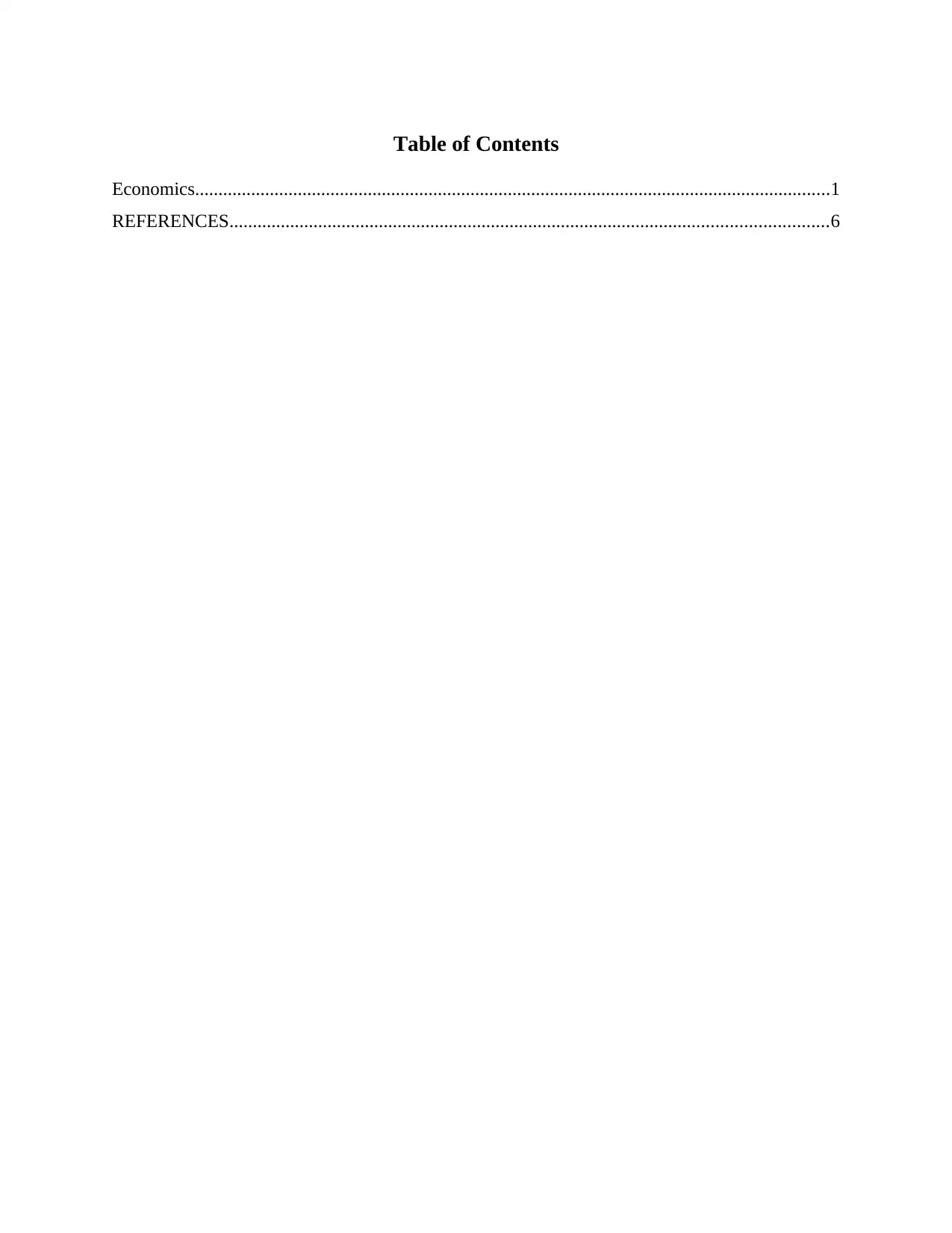
Table of Contents
Economics........................................................................................................................................1
REFERENCES................................................................................................................................6
Economics........................................................................................................................................1
REFERENCES................................................................................................................................6
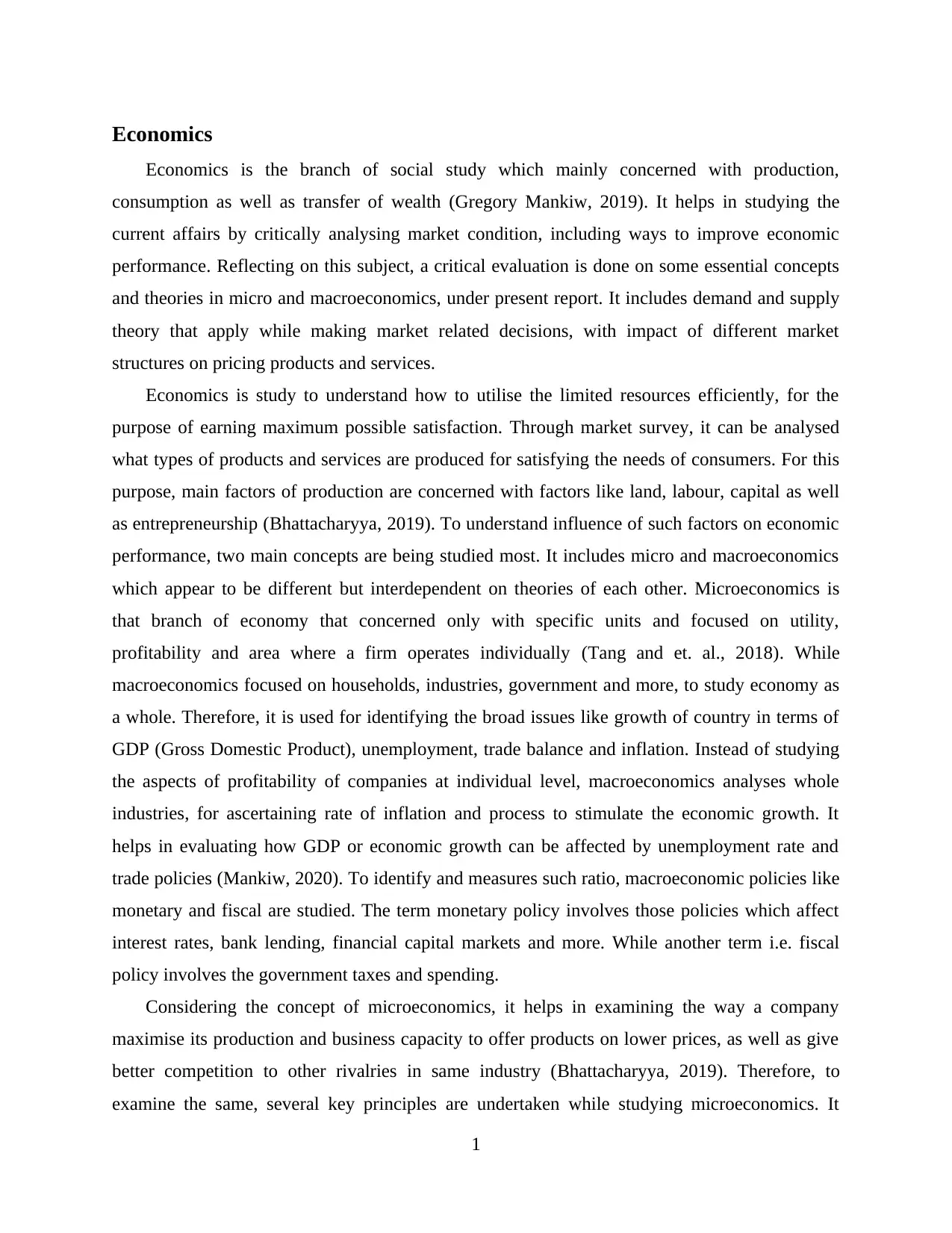
Economics
Economics is the branch of social study which mainly concerned with production,
consumption as well as transfer of wealth (Gregory Mankiw, 2019). It helps in studying the
current affairs by critically analysing market condition, including ways to improve economic
performance. Reflecting on this subject, a critical evaluation is done on some essential concepts
and theories in micro and macroeconomics, under present report. It includes demand and supply
theory that apply while making market related decisions, with impact of different market
structures on pricing products and services.
Economics is study to understand how to utilise the limited resources efficiently, for the
purpose of earning maximum possible satisfaction. Through market survey, it can be analysed
what types of products and services are produced for satisfying the needs of consumers. For this
purpose, main factors of production are concerned with factors like land, labour, capital as well
as entrepreneurship (Bhattacharyya, 2019). To understand influence of such factors on economic
performance, two main concepts are being studied most. It includes micro and macroeconomics
which appear to be different but interdependent on theories of each other. Microeconomics is
that branch of economy that concerned only with specific units and focused on utility,
profitability and area where a firm operates individually (Tang and et. al., 2018). While
macroeconomics focused on households, industries, government and more, to study economy as
a whole. Therefore, it is used for identifying the broad issues like growth of country in terms of
GDP (Gross Domestic Product), unemployment, trade balance and inflation. Instead of studying
the aspects of profitability of companies at individual level, macroeconomics analyses whole
industries, for ascertaining rate of inflation and process to stimulate the economic growth. It
helps in evaluating how GDP or economic growth can be affected by unemployment rate and
trade policies (Mankiw, 2020). To identify and measures such ratio, macroeconomic policies like
monetary and fiscal are studied. The term monetary policy involves those policies which affect
interest rates, bank lending, financial capital markets and more. While another term i.e. fiscal
policy involves the government taxes and spending.
Considering the concept of microeconomics, it helps in examining the way a company
maximise its production and business capacity to offer products on lower prices, as well as give
better competition to other rivalries in same industry (Bhattacharyya, 2019). Therefore, to
examine the same, several key principles are undertaken while studying microeconomics. It
1
Economics is the branch of social study which mainly concerned with production,
consumption as well as transfer of wealth (Gregory Mankiw, 2019). It helps in studying the
current affairs by critically analysing market condition, including ways to improve economic
performance. Reflecting on this subject, a critical evaluation is done on some essential concepts
and theories in micro and macroeconomics, under present report. It includes demand and supply
theory that apply while making market related decisions, with impact of different market
structures on pricing products and services.
Economics is study to understand how to utilise the limited resources efficiently, for the
purpose of earning maximum possible satisfaction. Through market survey, it can be analysed
what types of products and services are produced for satisfying the needs of consumers. For this
purpose, main factors of production are concerned with factors like land, labour, capital as well
as entrepreneurship (Bhattacharyya, 2019). To understand influence of such factors on economic
performance, two main concepts are being studied most. It includes micro and macroeconomics
which appear to be different but interdependent on theories of each other. Microeconomics is
that branch of economy that concerned only with specific units and focused on utility,
profitability and area where a firm operates individually (Tang and et. al., 2018). While
macroeconomics focused on households, industries, government and more, to study economy as
a whole. Therefore, it is used for identifying the broad issues like growth of country in terms of
GDP (Gross Domestic Product), unemployment, trade balance and inflation. Instead of studying
the aspects of profitability of companies at individual level, macroeconomics analyses whole
industries, for ascertaining rate of inflation and process to stimulate the economic growth. It
helps in evaluating how GDP or economic growth can be affected by unemployment rate and
trade policies (Mankiw, 2020). To identify and measures such ratio, macroeconomic policies like
monetary and fiscal are studied. The term monetary policy involves those policies which affect
interest rates, bank lending, financial capital markets and more. While another term i.e. fiscal
policy involves the government taxes and spending.
Considering the concept of microeconomics, it helps in examining the way a company
maximise its production and business capacity to offer products on lower prices, as well as give
better competition to other rivalries in same industry (Bhattacharyya, 2019). Therefore, to
examine the same, several key principles are undertaken while studying microeconomics. It
1
⊘ This is a preview!⊘
Do you want full access?
Subscribe today to unlock all pages.

Trusted by 1+ million students worldwide
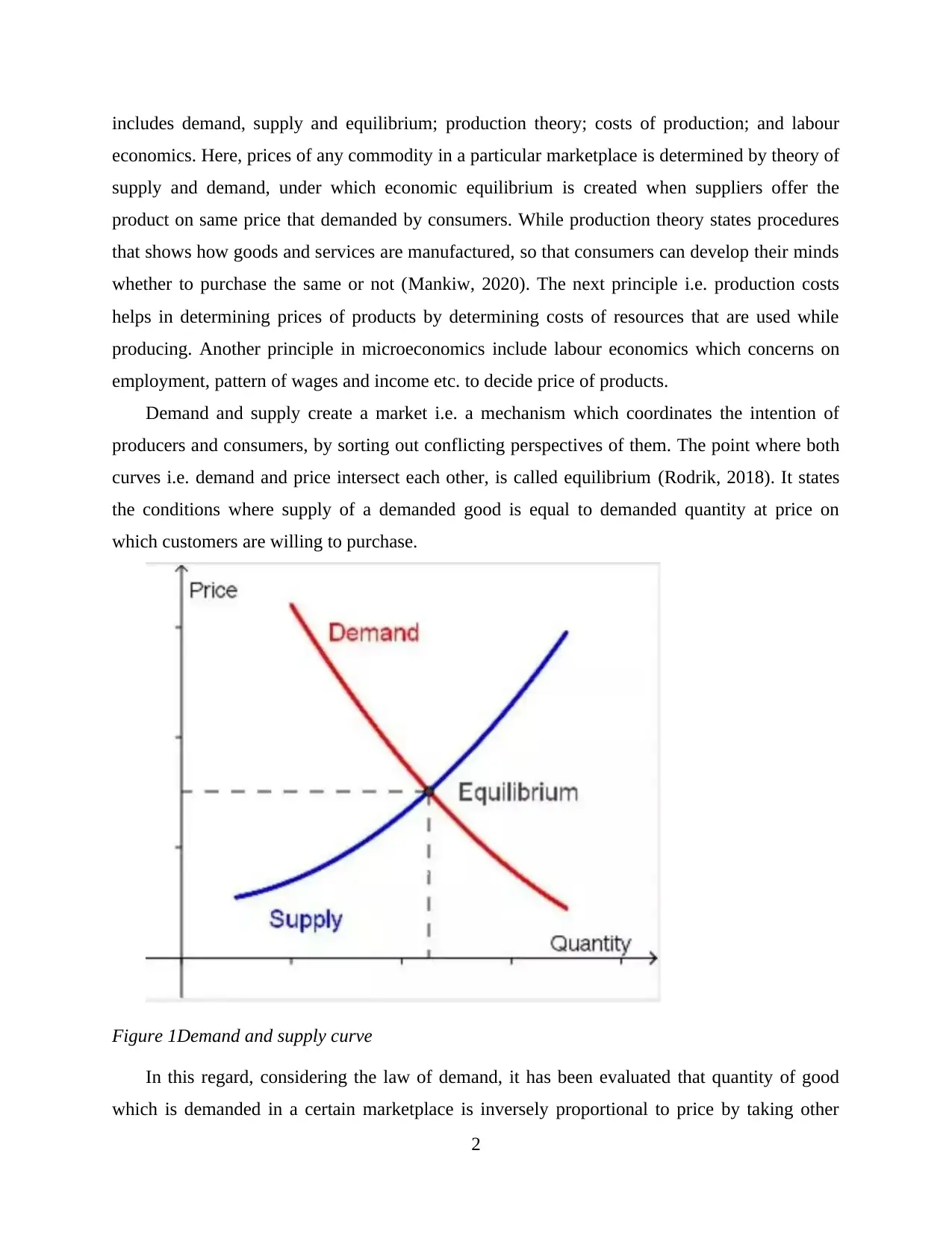
includes demand, supply and equilibrium; production theory; costs of production; and labour
economics. Here, prices of any commodity in a particular marketplace is determined by theory of
supply and demand, under which economic equilibrium is created when suppliers offer the
product on same price that demanded by consumers. While production theory states procedures
that shows how goods and services are manufactured, so that consumers can develop their minds
whether to purchase the same or not (Mankiw, 2020). The next principle i.e. production costs
helps in determining prices of products by determining costs of resources that are used while
producing. Another principle in microeconomics include labour economics which concerns on
employment, pattern of wages and income etc. to decide price of products.
Demand and supply create a market i.e. a mechanism which coordinates the intention of
producers and consumers, by sorting out conflicting perspectives of them. The point where both
curves i.e. demand and price intersect each other, is called equilibrium (Rodrik, 2018). It states
the conditions where supply of a demanded good is equal to demanded quantity at price on
which customers are willing to purchase.
Figure 1Demand and supply curve
In this regard, considering the law of demand, it has been evaluated that quantity of good
which is demanded in a certain marketplace is inversely proportional to price by taking other
2
economics. Here, prices of any commodity in a particular marketplace is determined by theory of
supply and demand, under which economic equilibrium is created when suppliers offer the
product on same price that demanded by consumers. While production theory states procedures
that shows how goods and services are manufactured, so that consumers can develop their minds
whether to purchase the same or not (Mankiw, 2020). The next principle i.e. production costs
helps in determining prices of products by determining costs of resources that are used while
producing. Another principle in microeconomics include labour economics which concerns on
employment, pattern of wages and income etc. to decide price of products.
Demand and supply create a market i.e. a mechanism which coordinates the intention of
producers and consumers, by sorting out conflicting perspectives of them. The point where both
curves i.e. demand and price intersect each other, is called equilibrium (Rodrik, 2018). It states
the conditions where supply of a demanded good is equal to demanded quantity at price on
which customers are willing to purchase.
Figure 1Demand and supply curve
In this regard, considering the law of demand, it has been evaluated that quantity of good
which is demanded in a certain marketplace is inversely proportional to price by taking other
2
Paraphrase This Document
Need a fresh take? Get an instant paraphrase of this document with our AI Paraphraser
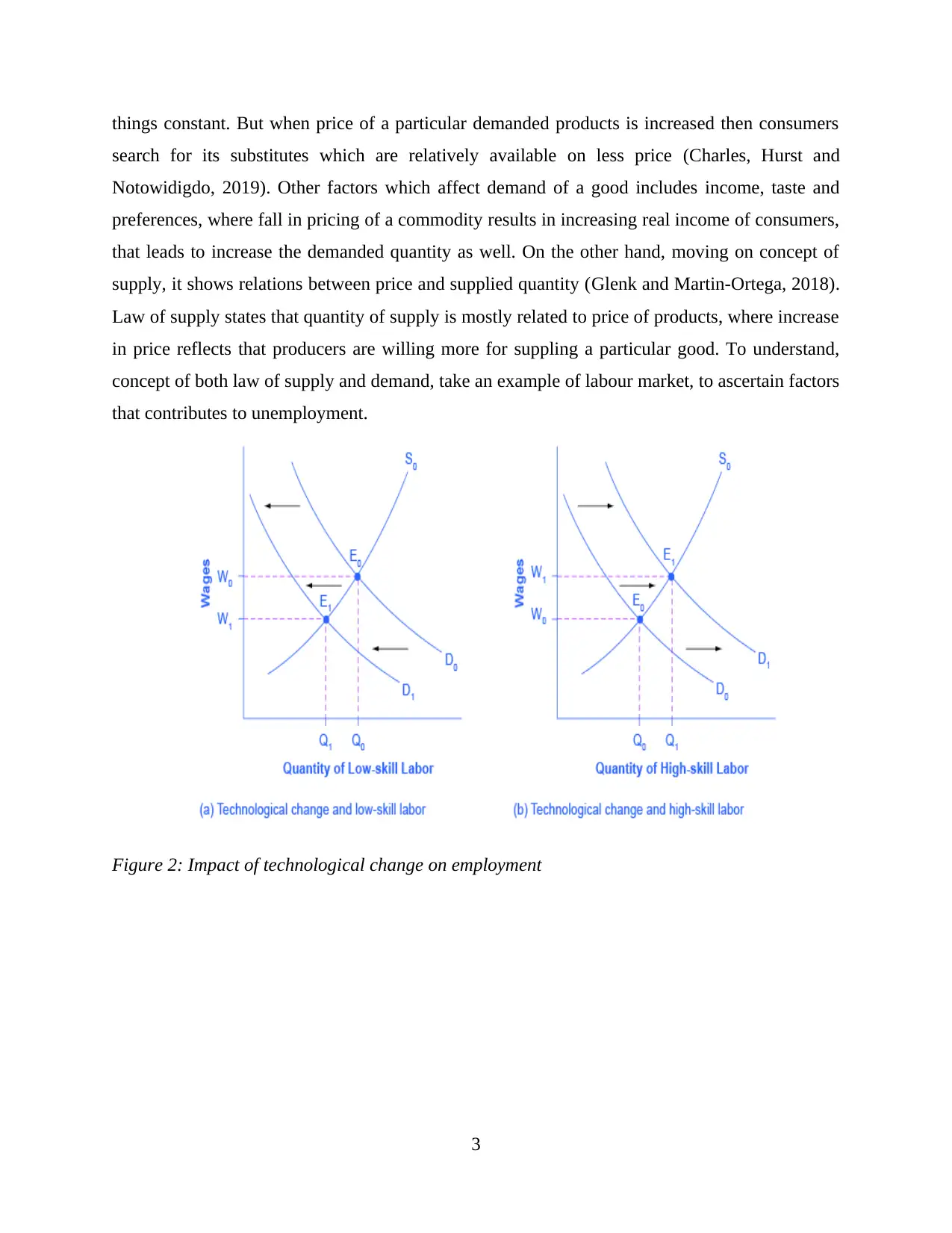
things constant. But when price of a particular demanded products is increased then consumers
search for its substitutes which are relatively available on less price (Charles, Hurst and
Notowidigdo, 2019). Other factors which affect demand of a good includes income, taste and
preferences, where fall in pricing of a commodity results in increasing real income of consumers,
that leads to increase the demanded quantity as well. On the other hand, moving on concept of
supply, it shows relations between price and supplied quantity (Glenk and Martin-Ortega, 2018).
Law of supply states that quantity of supply is mostly related to price of products, where increase
in price reflects that producers are willing more for suppling a particular good. To understand,
concept of both law of supply and demand, take an example of labour market, to ascertain factors
that contributes to unemployment.
Figure 2: Impact of technological change on employment
3
search for its substitutes which are relatively available on less price (Charles, Hurst and
Notowidigdo, 2019). Other factors which affect demand of a good includes income, taste and
preferences, where fall in pricing of a commodity results in increasing real income of consumers,
that leads to increase the demanded quantity as well. On the other hand, moving on concept of
supply, it shows relations between price and supplied quantity (Glenk and Martin-Ortega, 2018).
Law of supply states that quantity of supply is mostly related to price of products, where increase
in price reflects that producers are willing more for suppling a particular good. To understand,
concept of both law of supply and demand, take an example of labour market, to ascertain factors
that contributes to unemployment.
Figure 2: Impact of technological change on employment
3
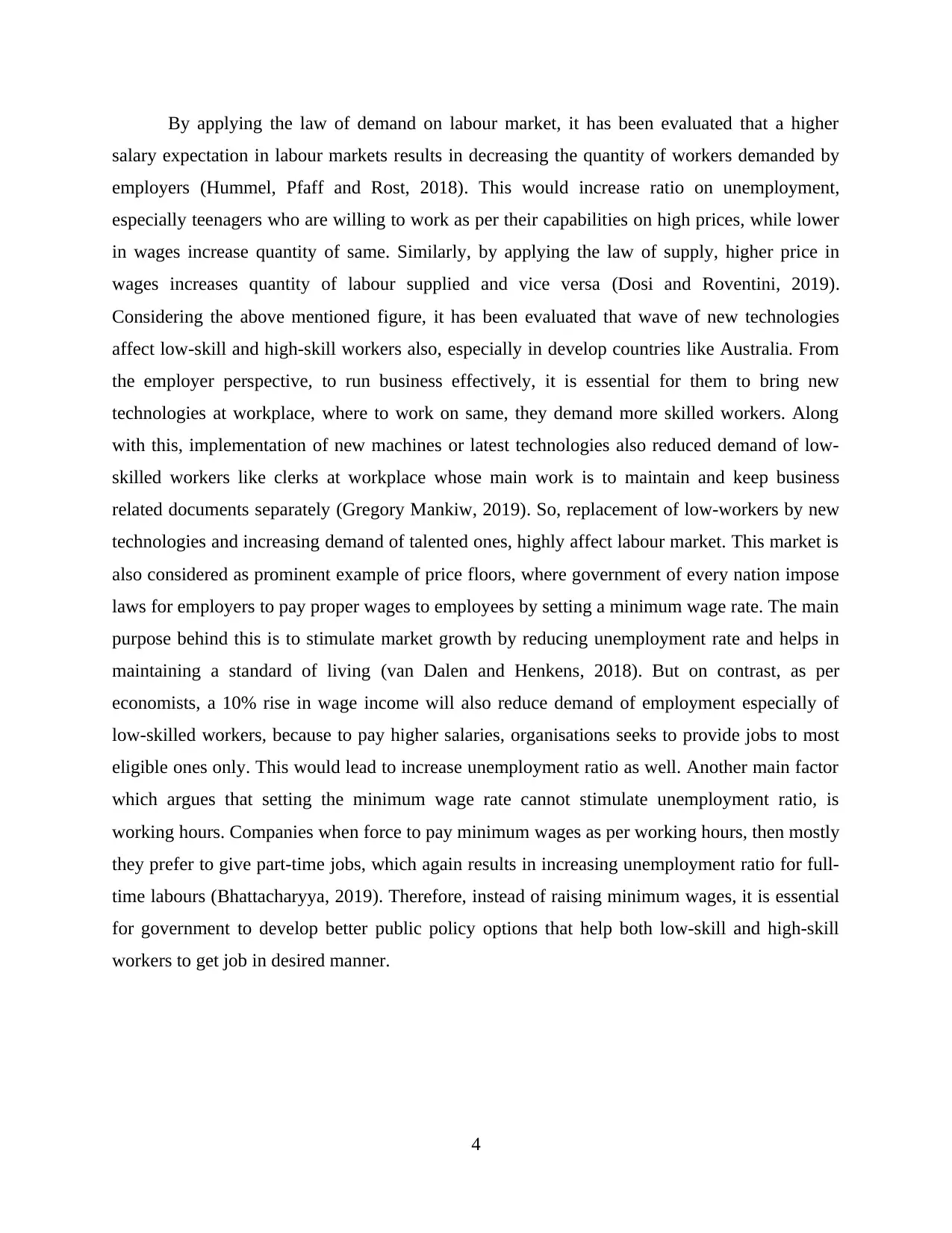
By applying the law of demand on labour market, it has been evaluated that a higher
salary expectation in labour markets results in decreasing the quantity of workers demanded by
employers (Hummel, Pfaff and Rost, 2018). This would increase ratio on unemployment,
especially teenagers who are willing to work as per their capabilities on high prices, while lower
in wages increase quantity of same. Similarly, by applying the law of supply, higher price in
wages increases quantity of labour supplied and vice versa (Dosi and Roventini, 2019).
Considering the above mentioned figure, it has been evaluated that wave of new technologies
affect low-skill and high-skill workers also, especially in develop countries like Australia. From
the employer perspective, to run business effectively, it is essential for them to bring new
technologies at workplace, where to work on same, they demand more skilled workers. Along
with this, implementation of new machines or latest technologies also reduced demand of low-
skilled workers like clerks at workplace whose main work is to maintain and keep business
related documents separately (Gregory Mankiw, 2019). So, replacement of low-workers by new
technologies and increasing demand of talented ones, highly affect labour market. This market is
also considered as prominent example of price floors, where government of every nation impose
laws for employers to pay proper wages to employees by setting a minimum wage rate. The main
purpose behind this is to stimulate market growth by reducing unemployment rate and helps in
maintaining a standard of living (van Dalen and Henkens, 2018). But on contrast, as per
economists, a 10% rise in wage income will also reduce demand of employment especially of
low-skilled workers, because to pay higher salaries, organisations seeks to provide jobs to most
eligible ones only. This would lead to increase unemployment ratio as well. Another main factor
which argues that setting the minimum wage rate cannot stimulate unemployment ratio, is
working hours. Companies when force to pay minimum wages as per working hours, then mostly
they prefer to give part-time jobs, which again results in increasing unemployment ratio for full-
time labours (Bhattacharyya, 2019). Therefore, instead of raising minimum wages, it is essential
for government to develop better public policy options that help both low-skill and high-skill
workers to get job in desired manner.
4
salary expectation in labour markets results in decreasing the quantity of workers demanded by
employers (Hummel, Pfaff and Rost, 2018). This would increase ratio on unemployment,
especially teenagers who are willing to work as per their capabilities on high prices, while lower
in wages increase quantity of same. Similarly, by applying the law of supply, higher price in
wages increases quantity of labour supplied and vice versa (Dosi and Roventini, 2019).
Considering the above mentioned figure, it has been evaluated that wave of new technologies
affect low-skill and high-skill workers also, especially in develop countries like Australia. From
the employer perspective, to run business effectively, it is essential for them to bring new
technologies at workplace, where to work on same, they demand more skilled workers. Along
with this, implementation of new machines or latest technologies also reduced demand of low-
skilled workers like clerks at workplace whose main work is to maintain and keep business
related documents separately (Gregory Mankiw, 2019). So, replacement of low-workers by new
technologies and increasing demand of talented ones, highly affect labour market. This market is
also considered as prominent example of price floors, where government of every nation impose
laws for employers to pay proper wages to employees by setting a minimum wage rate. The main
purpose behind this is to stimulate market growth by reducing unemployment rate and helps in
maintaining a standard of living (van Dalen and Henkens, 2018). But on contrast, as per
economists, a 10% rise in wage income will also reduce demand of employment especially of
low-skilled workers, because to pay higher salaries, organisations seeks to provide jobs to most
eligible ones only. This would lead to increase unemployment ratio as well. Another main factor
which argues that setting the minimum wage rate cannot stimulate unemployment ratio, is
working hours. Companies when force to pay minimum wages as per working hours, then mostly
they prefer to give part-time jobs, which again results in increasing unemployment ratio for full-
time labours (Bhattacharyya, 2019). Therefore, instead of raising minimum wages, it is essential
for government to develop better public policy options that help both low-skill and high-skill
workers to get job in desired manner.
4
⊘ This is a preview!⊘
Do you want full access?
Subscribe today to unlock all pages.

Trusted by 1+ million students worldwide
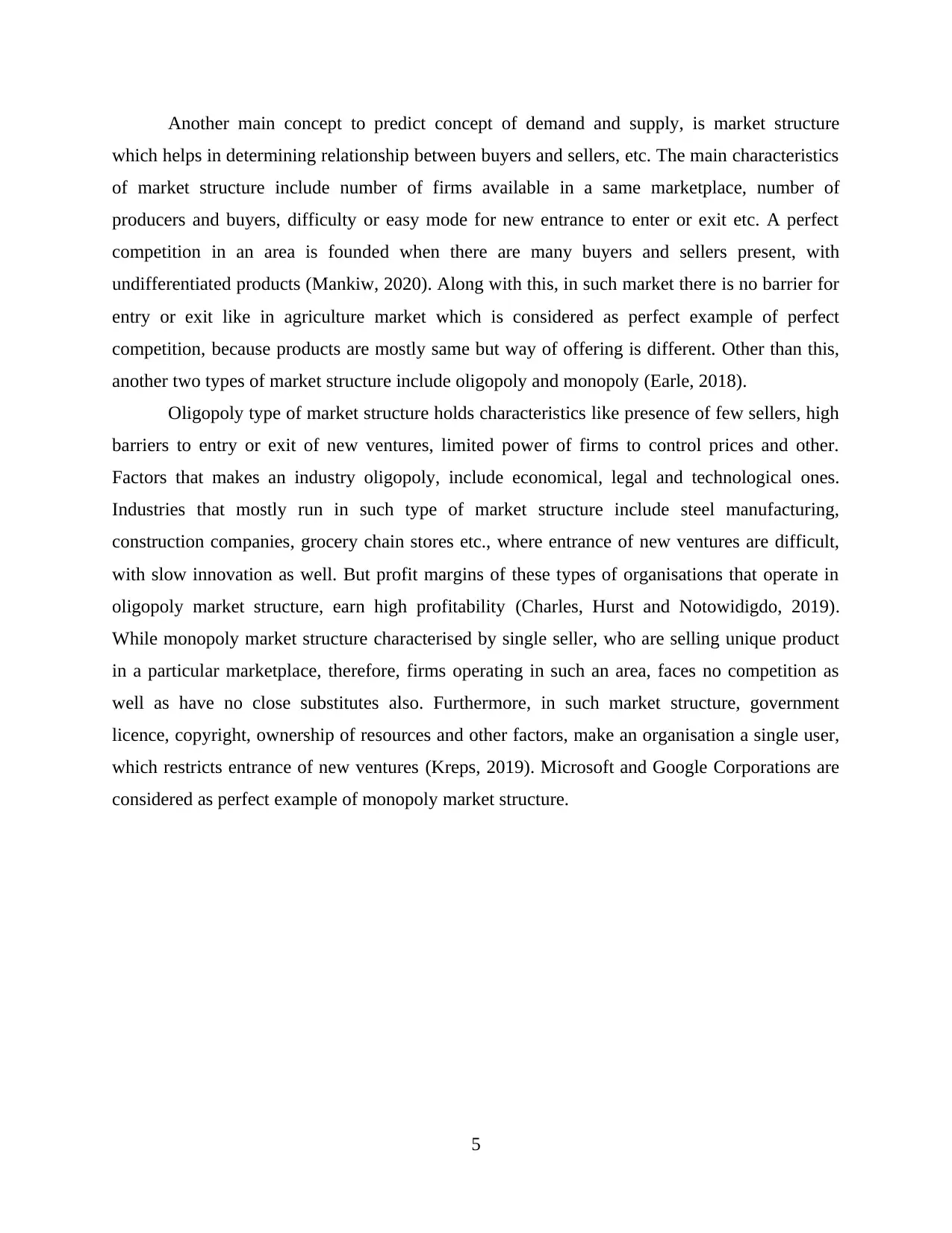
Another main concept to predict concept of demand and supply, is market structure
which helps in determining relationship between buyers and sellers, etc. The main characteristics
of market structure include number of firms available in a same marketplace, number of
producers and buyers, difficulty or easy mode for new entrance to enter or exit etc. A perfect
competition in an area is founded when there are many buyers and sellers present, with
undifferentiated products (Mankiw, 2020). Along with this, in such market there is no barrier for
entry or exit like in agriculture market which is considered as perfect example of perfect
competition, because products are mostly same but way of offering is different. Other than this,
another two types of market structure include oligopoly and monopoly (Earle, 2018).
Oligopoly type of market structure holds characteristics like presence of few sellers, high
barriers to entry or exit of new ventures, limited power of firms to control prices and other.
Factors that makes an industry oligopoly, include economical, legal and technological ones.
Industries that mostly run in such type of market structure include steel manufacturing,
construction companies, grocery chain stores etc., where entrance of new ventures are difficult,
with slow innovation as well. But profit margins of these types of organisations that operate in
oligopoly market structure, earn high profitability (Charles, Hurst and Notowidigdo, 2019).
While monopoly market structure characterised by single seller, who are selling unique product
in a particular marketplace, therefore, firms operating in such an area, faces no competition as
well as have no close substitutes also. Furthermore, in such market structure, government
licence, copyright, ownership of resources and other factors, make an organisation a single user,
which restricts entrance of new ventures (Kreps, 2019). Microsoft and Google Corporations are
considered as perfect example of monopoly market structure.
5
which helps in determining relationship between buyers and sellers, etc. The main characteristics
of market structure include number of firms available in a same marketplace, number of
producers and buyers, difficulty or easy mode for new entrance to enter or exit etc. A perfect
competition in an area is founded when there are many buyers and sellers present, with
undifferentiated products (Mankiw, 2020). Along with this, in such market there is no barrier for
entry or exit like in agriculture market which is considered as perfect example of perfect
competition, because products are mostly same but way of offering is different. Other than this,
another two types of market structure include oligopoly and monopoly (Earle, 2018).
Oligopoly type of market structure holds characteristics like presence of few sellers, high
barriers to entry or exit of new ventures, limited power of firms to control prices and other.
Factors that makes an industry oligopoly, include economical, legal and technological ones.
Industries that mostly run in such type of market structure include steel manufacturing,
construction companies, grocery chain stores etc., where entrance of new ventures are difficult,
with slow innovation as well. But profit margins of these types of organisations that operate in
oligopoly market structure, earn high profitability (Charles, Hurst and Notowidigdo, 2019).
While monopoly market structure characterised by single seller, who are selling unique product
in a particular marketplace, therefore, firms operating in such an area, faces no competition as
well as have no close substitutes also. Furthermore, in such market structure, government
licence, copyright, ownership of resources and other factors, make an organisation a single user,
which restricts entrance of new ventures (Kreps, 2019). Microsoft and Google Corporations are
considered as perfect example of monopoly market structure.
5
Paraphrase This Document
Need a fresh take? Get an instant paraphrase of this document with our AI Paraphraser
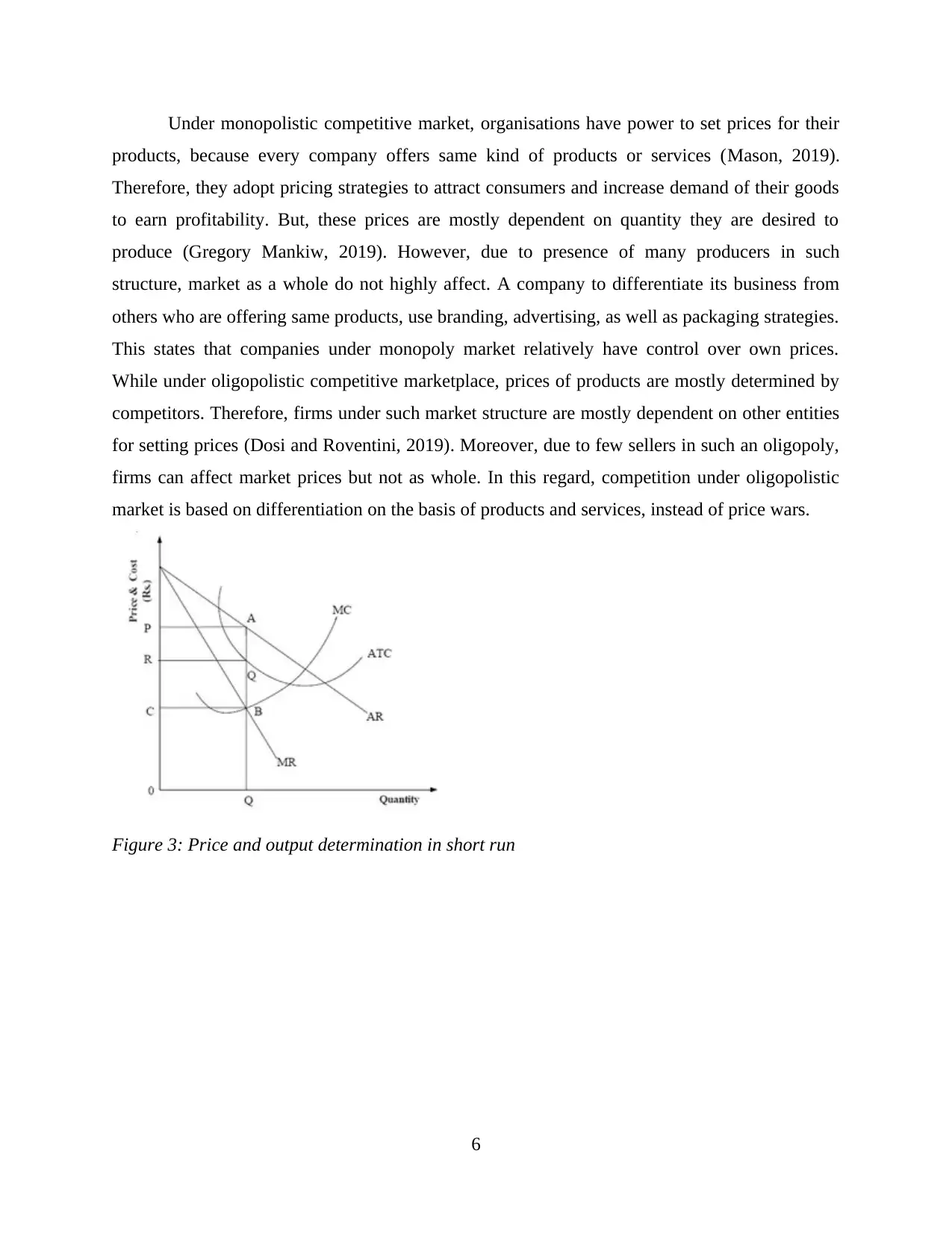
Under monopolistic competitive market, organisations have power to set prices for their
products, because every company offers same kind of products or services (Mason, 2019).
Therefore, they adopt pricing strategies to attract consumers and increase demand of their goods
to earn profitability. But, these prices are mostly dependent on quantity they are desired to
produce (Gregory Mankiw, 2019). However, due to presence of many producers in such
structure, market as a whole do not highly affect. A company to differentiate its business from
others who are offering same products, use branding, advertising, as well as packaging strategies.
This states that companies under monopoly market relatively have control over own prices.
While under oligopolistic competitive marketplace, prices of products are mostly determined by
competitors. Therefore, firms under such market structure are mostly dependent on other entities
for setting prices (Dosi and Roventini, 2019). Moreover, due to few sellers in such an oligopoly,
firms can affect market prices but not as whole. In this regard, competition under oligopolistic
market is based on differentiation on the basis of products and services, instead of price wars.
Figure 3: Price and output determination in short run
6
products, because every company offers same kind of products or services (Mason, 2019).
Therefore, they adopt pricing strategies to attract consumers and increase demand of their goods
to earn profitability. But, these prices are mostly dependent on quantity they are desired to
produce (Gregory Mankiw, 2019). However, due to presence of many producers in such
structure, market as a whole do not highly affect. A company to differentiate its business from
others who are offering same products, use branding, advertising, as well as packaging strategies.
This states that companies under monopoly market relatively have control over own prices.
While under oligopolistic competitive marketplace, prices of products are mostly determined by
competitors. Therefore, firms under such market structure are mostly dependent on other entities
for setting prices (Dosi and Roventini, 2019). Moreover, due to few sellers in such an oligopoly,
firms can affect market prices but not as whole. In this regard, competition under oligopolistic
market is based on differentiation on the basis of products and services, instead of price wars.
Figure 3: Price and output determination in short run
6
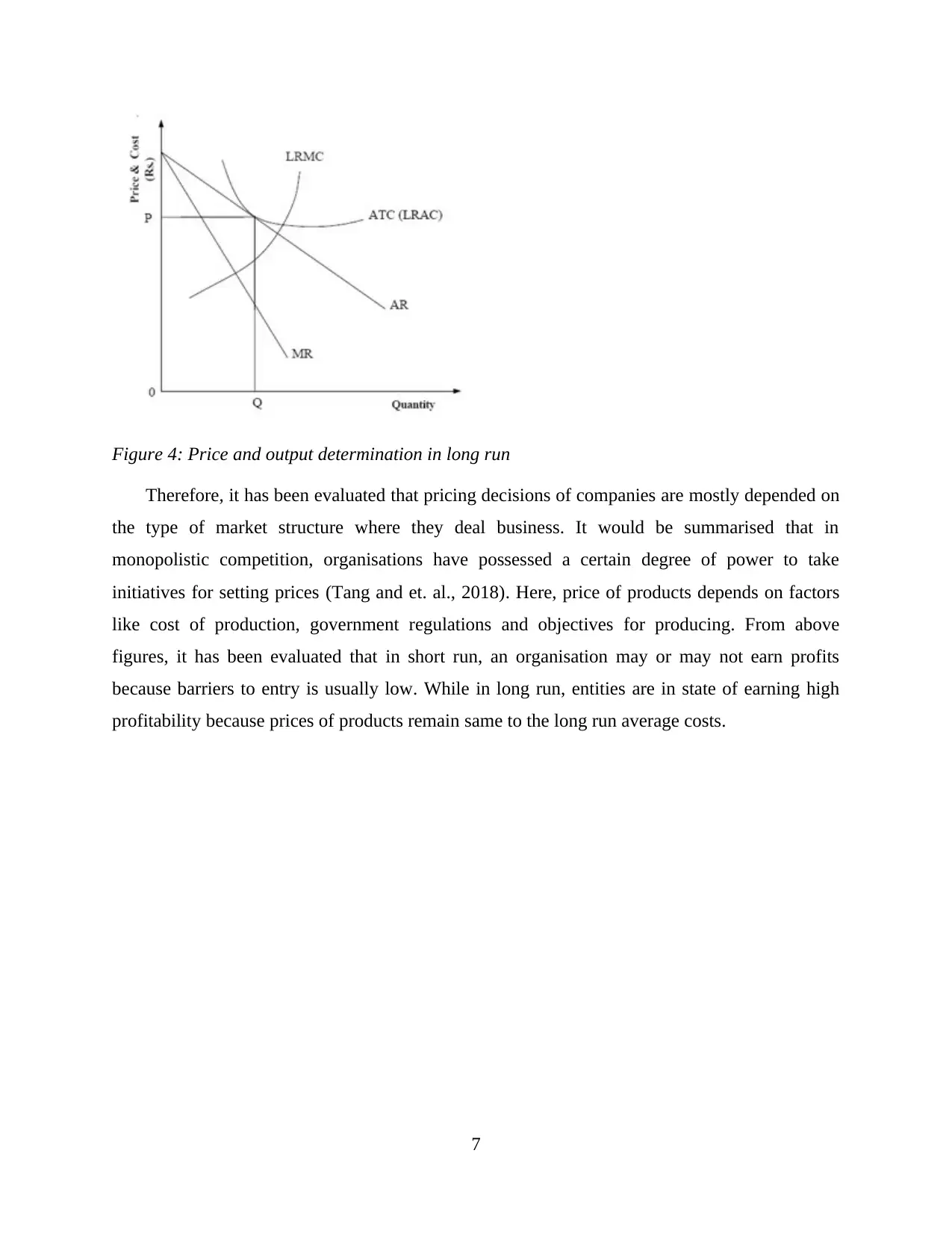
Figure 4: Price and output determination in long run
Therefore, it has been evaluated that pricing decisions of companies are mostly depended on
the type of market structure where they deal business. It would be summarised that in
monopolistic competition, organisations have possessed a certain degree of power to take
initiatives for setting prices (Tang and et. al., 2018). Here, price of products depends on factors
like cost of production, government regulations and objectives for producing. From above
figures, it has been evaluated that in short run, an organisation may or may not earn profits
because barriers to entry is usually low. While in long run, entities are in state of earning high
profitability because prices of products remain same to the long run average costs.
7
Therefore, it has been evaluated that pricing decisions of companies are mostly depended on
the type of market structure where they deal business. It would be summarised that in
monopolistic competition, organisations have possessed a certain degree of power to take
initiatives for setting prices (Tang and et. al., 2018). Here, price of products depends on factors
like cost of production, government regulations and objectives for producing. From above
figures, it has been evaluated that in short run, an organisation may or may not earn profits
because barriers to entry is usually low. While in long run, entities are in state of earning high
profitability because prices of products remain same to the long run average costs.
7
⊘ This is a preview!⊘
Do you want full access?
Subscribe today to unlock all pages.

Trusted by 1+ million students worldwide

REFERENCES
Books and Journals
Bhattacharyya, S. C. (2019). Energy economics: concepts, issues, markets and governance.
Springer Nature.
Mankiw, N. G. (2020). Essentials of economics. Cengage learning.
Frøyland, K., Andreassen, T. A., & Innvær, S. (2019). Contrasting supply-side, demand-side and
combined approaches to labour market integration. Journal of Social Policy, 48(2), 311-
328.
Charles, K. K., Hurst, E., & Notowidigdo, M. J. (2019). Housing booms, manufacturing decline
and labour market outcomes. The Economic Journal, 129(617), 209-248.
Dosi, G., & Roventini, A. (2019). More is different... and complex! the case for agent-based
macroeconomics. Journal of Evolutionary Economics, 29(1), 1-37.
Gregory Mankiw, N. (2019). Six guidelines for teaching intermediate macroeconomics. The
Journal of Economic Education, 50(3), 258-260.
Mason, R. M. (Ed.). (2019). Information services: Economics, management, and technology.
Routledge.
Kreps, D. M. (2019). Microeconomics for managers. Princeton University Press.
Earle, T. (2018). Bronze Age Economics: the first political economies. Routledge.
van Dalen, H. P., & Henkens, K. (2018). Why demotion of older workers is a no-go area for
managers. The International Journal of Human Resource Management, 29(15), 2303-
2329.
Hummel, K., Pfaff, D., & Rost, K. (2018). Does economics and business education wash away
moral judgment competence?. Journal of Business Ethics, 150(2), 559-577.
Glenk, K., & Martin-Ortega, J. (2018). The economics of peatland restoration. Journal of
Environmental Economics and Policy, 7(4), 345-362.
Rodrik, D. (2018). Populism and the Economics of Globalization. Journal of international
business policy, 1(1-2), 12-33.
Tang, T. L. P., & et. al. (2018). Monetary Intelligence and Behavioral Economics: The Enron
Effect—Love of money, corporate ethical values, Corruption Perceptions Index (CPI),
and dishonesty across 31 geopolitical entities. Journal of Business Ethics, 148(4), 919-
937.
8
Books and Journals
Bhattacharyya, S. C. (2019). Energy economics: concepts, issues, markets and governance.
Springer Nature.
Mankiw, N. G. (2020). Essentials of economics. Cengage learning.
Frøyland, K., Andreassen, T. A., & Innvær, S. (2019). Contrasting supply-side, demand-side and
combined approaches to labour market integration. Journal of Social Policy, 48(2), 311-
328.
Charles, K. K., Hurst, E., & Notowidigdo, M. J. (2019). Housing booms, manufacturing decline
and labour market outcomes. The Economic Journal, 129(617), 209-248.
Dosi, G., & Roventini, A. (2019). More is different... and complex! the case for agent-based
macroeconomics. Journal of Evolutionary Economics, 29(1), 1-37.
Gregory Mankiw, N. (2019). Six guidelines for teaching intermediate macroeconomics. The
Journal of Economic Education, 50(3), 258-260.
Mason, R. M. (Ed.). (2019). Information services: Economics, management, and technology.
Routledge.
Kreps, D. M. (2019). Microeconomics for managers. Princeton University Press.
Earle, T. (2018). Bronze Age Economics: the first political economies. Routledge.
van Dalen, H. P., & Henkens, K. (2018). Why demotion of older workers is a no-go area for
managers. The International Journal of Human Resource Management, 29(15), 2303-
2329.
Hummel, K., Pfaff, D., & Rost, K. (2018). Does economics and business education wash away
moral judgment competence?. Journal of Business Ethics, 150(2), 559-577.
Glenk, K., & Martin-Ortega, J. (2018). The economics of peatland restoration. Journal of
Environmental Economics and Policy, 7(4), 345-362.
Rodrik, D. (2018). Populism and the Economics of Globalization. Journal of international
business policy, 1(1-2), 12-33.
Tang, T. L. P., & et. al. (2018). Monetary Intelligence and Behavioral Economics: The Enron
Effect—Love of money, corporate ethical values, Corruption Perceptions Index (CPI),
and dishonesty across 31 geopolitical entities. Journal of Business Ethics, 148(4), 919-
937.
8
1 out of 10
Related Documents
Your All-in-One AI-Powered Toolkit for Academic Success.
+13062052269
info@desklib.com
Available 24*7 on WhatsApp / Email
![[object Object]](/_next/static/media/star-bottom.7253800d.svg)
Unlock your academic potential
Copyright © 2020–2025 A2Z Services. All Rights Reserved. Developed and managed by ZUCOL.




